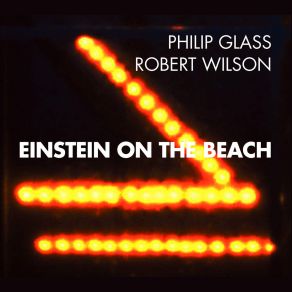Philip Glass: Einstein on the Beach (feat. Robert Wilson)
Download links and information about Philip Glass: Einstein on the Beach (feat. Robert Wilson) by Robert Wilson, Philip Glass, The Philip Glass Ensemble, Michael Riesman. This album was released in 1979 and it belongs to Theatre/Soundtrack, Opera genres. It contains 20 tracks with total duration of 03:36:52 minutes.

|
|
|---|---|
| Artist: | Robert Wilson, Philip Glass, The Philip Glass Ensemble, Michael Riesman |
| Release date: | 1979 |
| Genre: | Theatre/Soundtrack, Opera |
| Tracks: | 20 |
| Duration: | 03:36:52 |
| Buy it NOW at: | |
| Buy on iTunes $24.99 | |
Tracks
[Edit]| No. | Title | Length |
|---|---|---|
| 1. | Knee Play 1 (feat. Robert Wilson) | 7:04 |
| 2. | Act I, Scene 1: Train (feat. Robert Wilson) | 20:54 |
| 3. | Act I, Scene 2: Trial (Part 1) (feat. Robert Wilson) | 5:39 |
| 4. | Act I, Scene 2: Trial (Part 2) (feat. Robert Wilson) | 18:14 |
| 5. | Act I, Scene 2: Trial (Part 3) (feat. Robert Wilson) | 10:18 |
| 6. | Knee Play 2 (feat. Robert Wilson) | 6:15 |
| 7. | Act II, Scene 1: Dance 1 (feat. Robert Wilson) | 16:19 |
| 8. | Act II, Scene 2: Night Train (feat. Robert Wilson) | 15:48 |
| 9. | Knee Play 3 (feat. Robert Wilson) | 5:46 |
| 10. | Act III, Scene 1: Trial-Prison (Part 1) (feat. Robert Wilson) | 4:29 |
| 11. | Act III, Scene 1: Trial-Prison (Part 2) (feat. Robert Wilson) | 24:56 |
| 12. | Act III, Scene 1: Trial-Prison (Part 3) (feat. Robert Wilson) | 4:32 |
| 13. | Act III, Scene 2: Dance 2 (feat. Robert Wilson) | 19:20 |
| 14. | Knee Play 4 (feat. Robert Wilson) | 7:19 |
| 15. | Act IV, Scene 1: Building (feat. Robert Wilson) | 12:37 |
| 16. | Cadenza (feat. Robert Wilson) | 2:23 |
| 17. | Act IV, Scene 2: Bed (Part 1) (feat. Robert Wilson) | 3:32 |
| 18. | Act IV, Scene 2: Bed (Part 2) (feat. Robert Wilson) | 7:28 |
| 19. | Act IV, Scene 3: Spaceship (feat. Robert Wilson) | 15:06 |
| 20. | Knee Play 5 (feat. Robert Wilson) | 8:53 |
Details
[Edit]This opera, composed in 1975 and premiered in 1976, is scored for four principal actors, 12 singers doubling as dancers and actors, a solo violinist, and an amplified ensemble of keyboards, winds and voices. It is imbued with the postmodern spirit both in its non-linear, poetic, mystic narrative and the floating, eternal world created by the shifting, mathematically precise patterns of Philip Glass' modal music. There are three primary visual sets linked to three musical themes that recur within the work: trains (recalling the metaphors Einstein used to illustrate the theory of relativity, and with which he played as a child), a trial setting (modern life and modern science examined), and a spaceship (a metaphor for transcendence, and/or an escape from nuclear disaster). Also, Einstein himself appears midway between the orchestra and the stage as a violinist (his hobby) and as observer/witness. There are also additional spoken texts written by Christopher Knowles, Samuel M. Johnson and Lucinda Childs, which appear in various arrangements for single and multiple voices. This work locates itself as a midpoint between the composer's early-'70s work, linking rhythmic and harmonic structures and his later series of operas and vocal works and film scores employing expanded narrative and/or timbral experiments. ~ "Blue" Gene Tyranny, Rovi